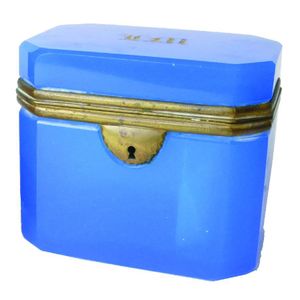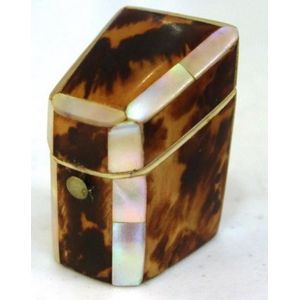Austrian Silver Box with Inscription and Gilded Lid
You must be a subscriber, and be logged in to view price and dealer details.
Subscribe Now to view actual auction price for this item
When you subscribe, you have the option of setting the currency in which to display prices to $Au, $US, $NZ or Stg.
- Sandalwood - Sandalwood is a heavy, yellow coloured and very fine-grained timber, which has a fragrance which lasts for many decades, and acts as a deterent to moths and insects.
In the British colonial era, sandalwood was imported into Britain from India, and the wood also used within India for the manufacture of Anglo-Indian furniture.
Becasue it does not have a distinct grain pattern, sandalwood was not used for the exterior surfaces of furniture, but was put to use for drawer and box linings, where the aroma was noticeable one the object was opened. it was also used to manufacture small objects (treen).
Nowadays sandalwood is commercially grown with Australia the largest producer. As well as producing timber, oil is extracted for use in the manufacture of perfumes. - Gilding - Gilding is a method of ornamentation whereby a thin sheet of gold metal is applied to items made of wood, leather, ceramics, glass and silver for decorative purposes.
For furniture including mirrors, the sheet of gold is usually applied over a coating of gesso. Gesso is a mixture of plaster of Paris and gypsum mixed with water and then applied to the carved wooden frames of mirrors and picture frames as a base for applying the gold leaf. After numerous coats of gesso have been applied, allowed to dry and then sanded a coat of "bole", a usually red coloured mixture of clay and glue is brushed on and allowed to dry, after which the gold leaf is applied. Over time parts of the gilding will rub off so the base colour can be seen. In water gilding, this was generally a blue colour, while in oil gilding, the under layer was often yellow. In Victorian times, gilders frequently used red as a pigment beneath the gold leaf.
Metal was often gilded by a process known as fire gilding. Gold mixed with mercury was applied and heated, causing the mercury to evaporate, the long-term effect of which was to kill or disable the craftsman or woman from mercury poisoning. The pursuit of beauty has claimed many victims, not the least of which were the artists who made those pieces so highly sought after today.
This item has been included into following indexes:
Visually similar items

A Continental bleu celeste glass tea caddy, rectangular shape with canted corners, gilt metal clashed edges and keyhole escutcheon, engraved monogram to the lid 'LM'. 11 cm x 8 cm x 10 cm

Antique needle case, with tortoise shell & mother of pearl decoration, 5 cm high approx.

Copper mounted brass tobacco tin and a pipe in the form of a rifle, & 2 store tobacco jars. (4 items)

An 18ct white gold triple cluster gem set ring; each cluster features a French cut aquamarine surrounded by round brilliant cut diamonds. Size P. Wt. 8.9g.
